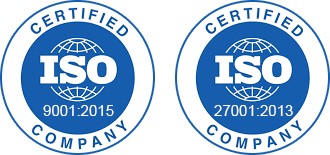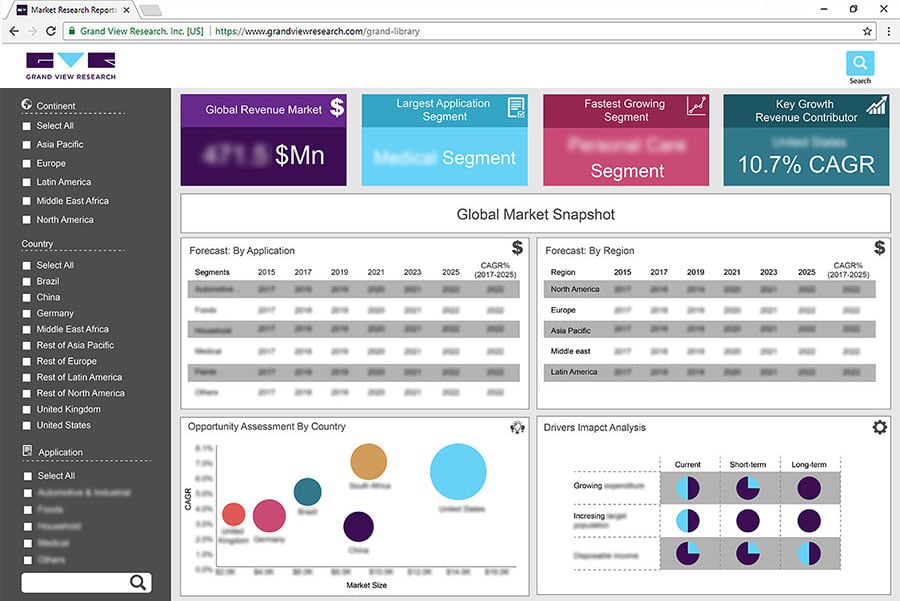- Home
- »
- Smart Textiles
- »
-
North America Self-contained Breathing Apparatus Market Report, 2025GVR Report cover
![North America Self-contained Breathing Apparatus Market Size, Share & Trends Report]()
North America Self-contained Breathing Apparatus Market Size, Share & Trends Analysis Report By End User (Fire Services, Chemical/Petrochemical, Law Enforcement, Military, & Navy, Mining), And Segment Forecasts, 2019 - 2025
- Report ID: GVR-4-68038-146-7
- Number of Report Pages: 70
- Format: PDF, Horizon Databook
- Historical Range: 2014 - 2017
- Forecast Period: 2019 - 2025
- Industry: Advanced Materials
Report Overview
The North America self-contained breathing apparatus market size to be valued at USD 962.2 million by 2025 and is expected to grow at a compound annual growth rate (CAGR) of 8.1% during the forecast period. Growing industries in North America, such as oil and gas, chemicals, and manufacturing, are anticipated to augment product demand on account of increasing workforce capacities. Demand for self-contained breathing apparatus is exponentially increasing as they provide the maximum level of protection available to wearers. This system is handy and admits no contaminated outside air into the apparatus. Furthermore, the product offers protection from surroundings that are oxygen-deficit or contain levels of contaminants that are above immediately dangerous to life or health (IDLH) concentrations, as defined by the U.S. National Institute for Occupational Safety and Health (NIOSH).
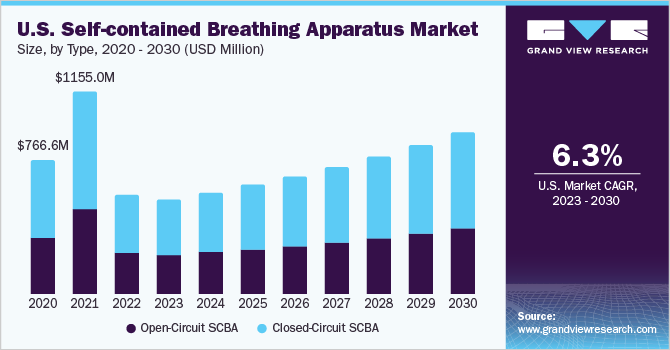
People are increasingly hiring private firms to supplement the firefighters provided by state and local governments in the U.S. Moreover, insurance companies are readily hiring/collaborating with firefighting crews to offer mitigation services to customers, which is expected to drive the demand for self-contained breathing apparatus over the coming years.
Increasing number of industrial accidents and injuries has forced regulating bodies to become more stringent. Federal and local agencies have been enforcing mandatory regulations and actions in order to reduce the occurrence of these accidents. For instance, updates in the standards developed by the National Fire Protection Association (NFPA), such as new voice intelligibility requirements, are expected to increase product demand over the forecast period.
Growing use of respiratory protective equipment in oil and gas drilling activities, electric power utility, and combustible dust industries has contributed to product penetration in the region over the past few years. Strict government policies regarding the safety of employees are also expected to boost demand for self-contained breathing apparatus over the coming years.
Carbon fiber, which is a preferred raw material in manufacturing self-contained breathing apparatus, suffered a price hike during mid-2012 on account of high dependency from aerospace and high-end automotive industries. Carbon fiber is majorly used in aircraft and high-end vehicles manufacturing. Increasing demand for fuel-efficient, lighter aircraft and automobiles is estimated to drive carbon fiber demand, which in turn is responsible for premium prices. This could hamper the global market.
North America Self-contained Breathing Apparatus Market Trends
The increasing number of fire incidents is a major factor driving the Self-Contained Breathing Apparatus (SCBA) market. The rising incidence of vehicle accidents and injuries is a vital element fueling market expansion. Furthermore, product penetration in the United States faces stringent regulations for the environment and increased employee awareness regarding safety. Devices with functions like reliability, lightweight, improvement, and ease of use are also being offered by the companies operating in the SCBA market to attract a larger customer base. The growth of the market in North America is expected to be driven by a rise in infrastructure improvements in the industrial sector.
The use of fire protection systems and the use of fire-resistant building materials are the key attributes acting as restraints for the SCBA market's growth. However, the training essential for safe usage and maintenance, as well as the limited-service life and length of oxygen delivery constrain the market growth.
The continuous efforts of various producers are working on the development and enhancement of SCBA that are increasingly employed in fumigated locations. The countries' industrial facilities are anticipated to grow as a result of favorable market circumstances such as highly trained workers and economical contemporary infrastructure. As a result, product demand in North America is relatively high in the next years. Modernization in self-contained breathing equipment creates new opportunities for the market.
End-user Insights
In terms of end-user, the North America self-contained breathing apparatus market is categorized into fire services, oil and gas, mining, chemical/petrochemical, industrial, law enforcement, military, and navy, and others. Growing concerns regarding airborne contaminants such as smoke, carbon monoxide, and toxic gases in waste remediation and petrochemical industries are expected to propel the demand for self-contained breathing apparatus over the forecast period.
Burgeoning industries such as automotive, metal forming, manufacturing, and glassmaking are anticipated to propel the demand for respiratory protection equipment. This can be attributed to rising in occupational health risks in the glass manufacturing industry, which is primarily related to the presence of fine airborne particulate matter (PM) such as lead oxide, boron, arsenic, tin, nickel, and cobalt.
Comfort plays a crucial role while manufacturing a self-contained breathing apparatus and it highly depends on the end-use application. For instance, if the product is only used in emergencies such as performing unexpected maintenance in a confined space or shutting down a leaking valve, then comfort would not be as crucial as it would be in other situations where these products are used on a regular basis, such as firefighting.
Country Insights
High product penetration in the U.S. is attributed to the stringent regulatory scenario and growing employee awareness regarding personal safety. Increasing number of largescale infrastructure investment projects in the industrial sector in New York, Missouri, and Los Angeles is expected to boost industry growth, thereby driving the demand for self-contained breathing apparatus in the U.S.
Favorable conditions such as availability of highly skilled labor at low cost, affordable modern infrastructure, and proximity to high-demand markets that ensure smooth exports for starting new manufacturing facilities in Mexico are expected to augment the number of manufacturing facilities in the country. This, in turn, is anticipated to have a positive impact on product demand in manufacturing applications.
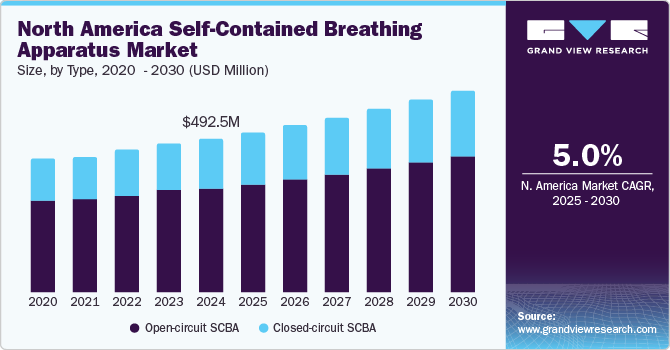
The manufacturing industry in Canada is projected to witness growth on account of increased investment in mining and transportation sectors, thereby, driving the demand for self-contained breathing apparatus. Manufacturing facilities are reaching their peak capacity utilization, thus, leading to increased requirement for new facilities. This is expected to boost product demand in construction and manufacturing applications.
Key Companies & Market Share Insights
The regional market is characterized by the presence of a large number of players such as Scott Safety, MSA, Dragerwerk, Avon Protection Systems, and Honeywell. The industry focuses on adopting strategies such as product portfolio expansion, product development, and distribution network expansion. In addition, manufacturers have adopted sustainable solutions to reap long-term benefits and ease the availability of raw materials.
Constant need for innovation and development on account of increasing user expectations and shifting health and safety regulations has forced manufacturers to spend more on R&D in order to develop efficient products. For instance, Honeywell is using radio frequency identification (RFID) tags on its products, which links it to firefighters in order to communicate any problems with the apparatus and receive evacuation notices from the command.
Recent Development
-
In July 2021, MSA Safety, a global safety equipment company, has finalized its acquisition of Bacharach, Inc. This acquisition is expected to help in product innovation in the region
-
In July 2021, MSA Safety, a global pioneer in the research, production, and delivery of safety equipment that safeguards people and facility infrastructures announced a joint development agreement with Perspective Robotics AG. This agreement is expected to firm enhance their fire service offerings
North America Self-contained Breathing Apparatus Market Report Scope
Report Attribute
Details
Revenue forecast in 2025
USD 962.2 million
Growth rate
CAGR of 8.1% from 2019 to 2025
Base year for estimation
2018
Historical data
2014 - 2017
Forecast period
2019 - 2025
Quantitative units
Revenue in USD million/billion and CAGR from 2019 to 2025
Report coverage
Revenue forecast, company ranking, competitive landscape, growth factors, and trends
Segments covered
End-user, region
Regional scope
North America
Country scope
U.S.; Canada; Mexico
Key companies profiled
Scott Safety; MSA; Dragerwerk; Avon Protection Systems; Honeywell.
Customization scope
Free report customization (equivalent to up to 8 analysts working days) with purchase. Addition or alteration to country, regional & segment scope.
Pricing and purchase options
Avail customized purchase options to meet your exact research needs. Explore purchase options
North America Self-contained Breathing Apparatus Market Segmentation
This report forecasts revenue growth at regional and country levels and provides an analysis of the latest industry trends in each of the sub-segments from 2014 to 2025. For the purpose of this study, Grand View Research has segmented the North America self-contained breathing apparatus market report on the basis of end-user and region:
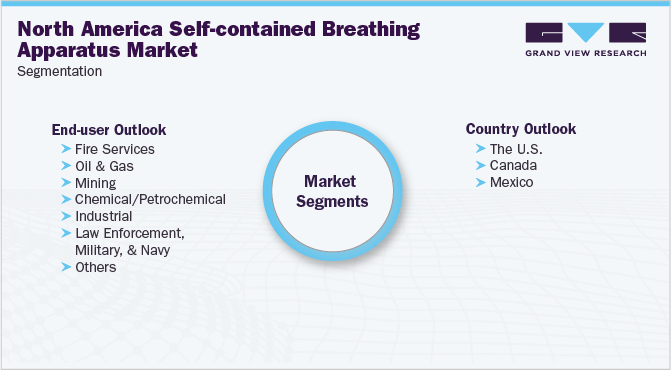
-
End-user Outlook (Revenue, USD Million, 2014 - 2025)
-
Fire Services
-
Oil & Gas
-
Mining
-
Chemical/Petrochemical
-
Industrial
-
Law Enforcement, Military, and Navy
-
Others
-
-
Country Outlook (Revenue, USD Million, 2014 - 2025)
-
The U.S.
-
Canada
-
Mexico
-
Share this report with your colleague or friend.
![gvr icn]()
NEED A CUSTOM REPORT?
We can customize every report - free of charge - including purchasing stand-alone sections or country-level reports, as well as offer affordable discounts for start-ups & universities. Contact us now
![Certified Icon]()
We are GDPR and CCPA compliant! Your transaction & personal information is safe and secure. For more details, please read our privacy policy.
We are committed towards customer satisfaction, and quality service.
"The quality of research they have done for us has been excellent."
